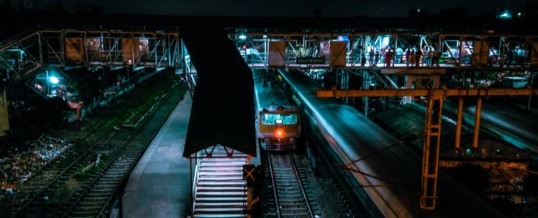
Believe it or not, it is common for people who live far from railroad tracks to hear trains at night and only at night. While this may be due to trains only running in the evening or due to lower overall sound levels in the nighttime, there is a surprising physical explanation why a person might hear a train in the nighttime and not in the day.
Sound waves, like other types of waves, experience bending or refraction when the medium they are traveling through changes. For example, this happens when light passes between air and water—the light refracts. To check out this effect, watch your fingers as you put your hand behind a glass of water. The image shifts because the light refracts as it passes through three media—air, glass and water.
Sound behaves similarly. As sound passes from one medium into the next, the speed of sound changes. The speed of sound in a material is dependent upon the structure of the particles that make it up, as well as the particles’ proximity to each other. In general, sound travels fastest in solids and slowest in gases. Liquids tend to fit in the middle, although their sound speeds are closer to solid speeds than to gas speeds.
In addition to the type of medium, temperature can influence the speed of sound. In air, sound speed (![]() ) in meters per second varies with temperature according to this equation:
) in meters per second varies with temperature according to this equation:
![]()
Note that temperature in this equation is in Kelvin.
What this equation shows is that it is possible to get refraction if the temperature changes. For example, when the sun goes down, temperatures shift. During the day, the sun warms the ground and temperatures are warmest close to the ground. However, once the sun sets, it is possible to have a temperature inversion. In a temperature inversion the air closest to the ground is cooler than the air above it. Temperature inversions are common over lakes and other bodies of water.
The change in air temperature affects the way sound travels. Since sound waves travel faster in warm air than in cool air, sound traveling through a temperature inversion bends. The blast of the train whistle under temperature inversion conditions can to bend upward, traveling quickly through the warm air high above the ground before spreading downward through the cool air closer to the ground and into your ear through an open bedroom window.
While there is little you can do about a temperature inversion, there are many ways to acoustically treat your room so that you don’t hear the train at night. If closing the window or wearing earplugs don’t work for you, an acoustical consultant can help.
This lesser-known acoustical phenomenon can have real implications for environmental noise. Research suggests that temperature inversions determined the outcome for several major battles of the American Civil War. So, if you’re hearing the train at night, don’t worry. You’re not crazy. It’s nothing a little acoustics can’t fix.
Reference:
https://www.acs.psu.edu/drussell/Demos/refract/refract.html
JUL
2019

About the Author: